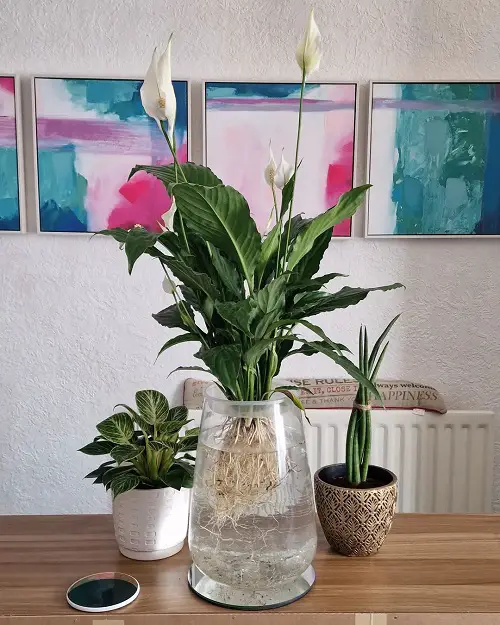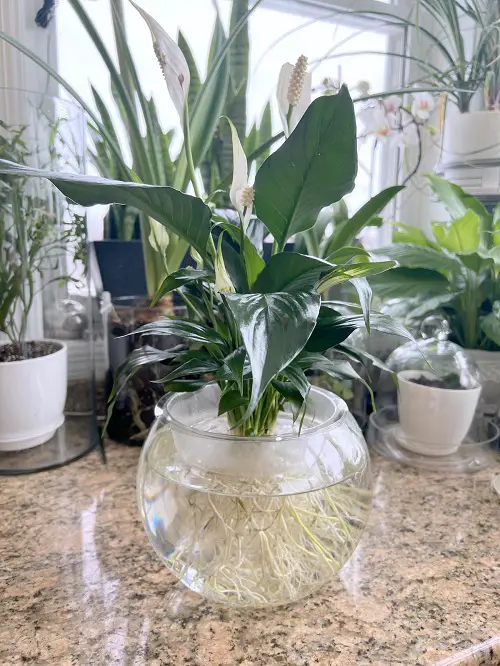Growing Peace Lily in Water is one of the easiest ways to keep this plant indoors anywhere you like. Here’s a step-by-step guide to doing it!

Growing Peace Lily in Water is the best way to handle this plant without worrying about growing mediums and big containers. Let’s have a look at the details!
Here are the Best Types of Peace Lily
Why You Must Grow Peace Lily in Water
Growing a peace lily in water indoors offers several advantages:
- Peace lilies grown in water require less maintenance compared to plants growing in soil. There’s no need to worry about soil quality, watering schedules, or potential pests and diseases associated with soil-grown plants.
- Growing peace lilies in water eliminate the need for pots or planters, making them suitable for compact spaces such as desks, shelves, or windowsills as centerpieces.
- Water-grown peace lilies offer more flexibility in terms of placement and decor. They can be easily moved around to different locations without the hassle of repotting.
- You can experiment with various containers and decorative elements to create unique displays.
Here are the Best Bulbs to Grow in Water + Growing Bulbs in Water
Step By Step Guide on Growing Peace Lily in Water
- Select a healthy Peace Lily: Choose a young peace lily plant or separate the pups from a mother plant with less developed roots but vibrant foliage for water propagation. It is because already established plant will have difficulty in adapting to a new growing medium.
- Select a Vase: Get a clean, clear container for growing the peace lily in water. It should be large enough to accommodate the plant’s roots and allow room for growth. A glass vase or jar works well for this purpose.
- Fill the container with water: Fill the container with distilled or filtered water. Avoid using tap water, as the chemicals and minerals in it can harm the plant. Let the water sit for a day or two to allow any chlorine to dissipate.
- Prepare the plant: Carefully remove the peace lily from its pot, taking care not to damage the roots. Gently rinse off the soil from the roots under running water to expose the root system.
- Place the plant in water: Submerge the spathiphyllum’s roots in the container of water. The leaves should remain above the water level.
- Provide indirect light: Place the container in a location that receives bright, indirect light. Avoid placing it in direct sunlight, as it can scorch the plant’s leaves.
- Maintain the water level: Check the water level regularly and keep it consistent. Ensure that the roots are always submerged in water. Add water as needed to maintain the appropriate level.
- Change the water periodically: Every two to three weeks, replace the water in the container to prevent stagnation and the buildup of algae. Rinse the container thoroughly before refilling it with fresh water.
- Monitor plant health: Watch for signs of health or stress in the spathiphyllum. Healthy roots will appear white and firm. If the roots turn brown or mushy, it may indicate root rot, and the plant should be removed from water and repotted in soil.
Follow the Daily-Weekly-Monthly: Indoor Plant Care Routine For Healthy Plants!
Quick Maintenance Tips for Peace Lily Growing in Water
- Use a balanced water-soluble fertilizer, and add a pinch of it in the jar with every 4th to 5th water change. This will be more than enough to support the growth of the plant.
- Every few months, it’s beneficial to rinse the roots of the peace lily under running water to remove any accumulated salts or fertilizer residues. This helps prevent potential nutrient imbalances and maintains the health of the plant.
- Regularly rinse and clean the container to prevent the growth of algae or bacteria.
- Remove any yellow or brown leaves promptly to maintain the plant’s appearance and overall health. Pruning also helps improve air circulation around the plant.
- Periodically inspect the roots of the peace lily for any signs of decay or root rot. If you notice brown or mushy roots, it may indicate an issue. In such cases, remove the plant from water, trim away affected roots, and repot it in freshwater or soil if necessary.


